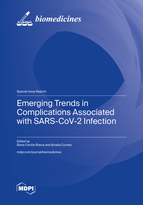Emerging Trends in Complications Associated with SARS-CoV-2 Infection
A special issue of Biomedicines (ISSN 2227-9059). This special issue belongs to the section "Molecular and Translational Medicine".
Deadline for manuscript submissions: closed (30 June 2023) | Viewed by 25997
Special Issue Editors
2. Department of Neurology, Clinical Emergency County Hospital, Timisoara, Romania
Interests: evidence-based medicine; movement disorders; cognition, basal ganglia; infectious diseases
Special Issues, Collections and Topics in MDPI journals
2. Department of Neurology, Clinical Emergency County Hospital, Timisoara, Romania
Interests: inflammation; epilepsy; movement disorders; evidence-based medicine; infectious diseases
Special Issues, Collections and Topics in MDPI journals
Special Issue Information
Dear Colleagues,
Coronavirus disease 2019 (COVID-19) is a serious respiratory disease that results from infection with severe acute respiratory syndrome coronavirus 2 (SARS-COV-2). Although several vaccines have been developed and programmes have been implemented globally, some patients may present various complications, including some that are life-threatening.
Different studies have shown a number of potential acute and chronic complications in patients with COVID-19. The spectrum of acute complications ranges from respiratory failure to cardiac and cardiovascular injury, liver and renal disorders, neurologic manifestations, secondary infections, and coinfections, as well as disseminated intravascular coagulation.
Unfortunately, COVID-19 is not only a short-term infection, but patients may also present with long-term complications. Post-COVID conditions are found more often after severe illness, but any patient may experience long COVID, even those who have mild illness or no symptoms.
Also, due to the intrinsic characteristics of SARS-CoV-2 infection, the elderly and patients with certain medical conditions have been demonstrated to be particularly at risk for various complications.
In this Special Issue, we hope to encourage proposals that critically analyze and discuss current knowledge on the clinical characteristics of the SARS-CoV-2 infection, focusing on the acute and long-term complications. We aim to present research and theoretical papers addressing the complications of COVID-19. Thus, we invite colleagues working and/or involved in any field related to SARS-CoV-2 infection to submit their work for publication in this Special Issue. Original papers, as well as reviews, are welcome.
Dr. Elena Cecilia Rosca
Dr. Amalia Cornea
Guest Editors
Manuscript Submission Information
Manuscripts should be submitted online at www.mdpi.com by registering and logging in to this website. Once you are registered, click here to go to the submission form. Manuscripts can be submitted until the deadline. All submissions that pass pre-check are peer-reviewed. Accepted papers will be published continuously in the journal (as soon as accepted) and will be listed together on the special issue website. Research articles, review articles as well as short communications are invited. For planned papers, a title and short abstract (about 100 words) can be sent to the Editorial Office for announcement on this website.
Submitted manuscripts should not have been published previously, nor be under consideration for publication elsewhere (except conference proceedings papers). All manuscripts are thoroughly refereed through a single-blind peer-review process. A guide for authors and other relevant information for submission of manuscripts is available on the Instructions for Authors page. Biomedicines is an international peer-reviewed open access monthly journal published by MDPI.
Please visit the Instructions for Authors page before submitting a manuscript. The Article Processing Charge (APC) for publication in this open access journal is 2600 CHF (Swiss Francs). Submitted papers should be well formatted and use good English. Authors may use MDPI's English editing service prior to publication or during author revisions.
Keywords
- SARS-CoV-2
- COVID-19
- complications
- acute injury
- long COVID







